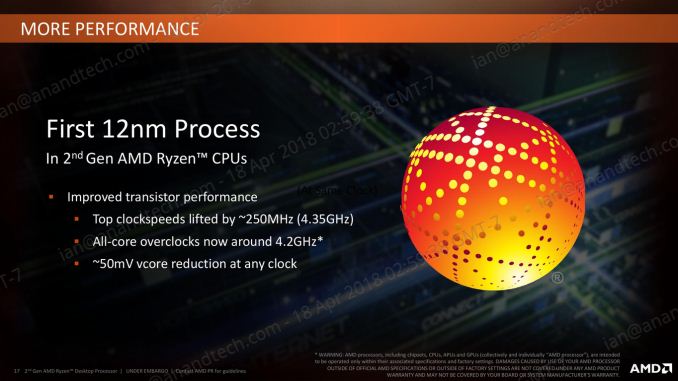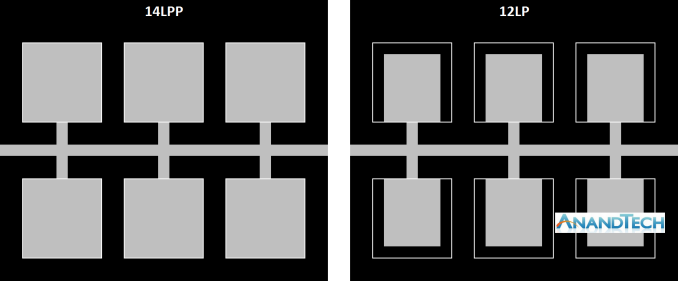The AMD 2nd Gen Ryzen Deep Dive: The 2700X, 2700, 2600X, and 2600 Tested
by Ian Cutress on April 19, 2018 9:00 AM ESTTalking 12nm and Zen+
One of the highlights of the Ryzen 2000-series launch is that these processors use GlobalFoundries’ 12LP manufacturing process, compared to the 14LPP process used for the first generation of Ryzen processors. Both AMD and GlobalFoundries have discussed the differences in the processes, however it is worth understanding that each company has different goals: AMD only needs to promote what helps its products, whereas GlobalFoundries is a semiconductor foundry with many clients and might promote ideal-scenario numbers. Earlier this year we were invited to GlobalFoundries Fab 8 in upstate New York to visit the clean room, and had a chance to interview Dr. Gary Patton, the CTO.
The Future of Silicon: An Exclusive Interview with Dr. Gary Patton, CTO of GlobalFoundries
In that interview, several interesting items came to light. First, that the CTO doesn’t necessarily have to care much about what certain processes are called: their customers know the performance of a given process regardless of the advertised ‘nm’ number based on the development tools given to them. Second, that 12LP is a series of minor tweaks to 14LPP, relating to performance bumps and improvements that come from a partial optical shrink and a slight change in manufacturing rules in the middle-line and back-end of the manufacturing process. In the past this might not have been so news worthy, however GF’s customers want to take advantage of the improved process.
Overall, GlobalFoundries has stated that its 12LP process offers a 10% performance improvement and a 15% circuit density improvement over 14LPP.
This has been interpreted in many ways, such as an extra 10% frequency at the same power, or lower power for the same frequency, and an opportunity to build smaller chips.
As part of today’s launch, AMD has clarified what the move to 12LP has meant for the Ryzen 2000-series:
- Top Clock Speeds lifted by ~250 MHz (~6%)
- All-core overclocks around 4.2 GHz
- ~50 mV core voltage reduction
AMD goes on to explain that at the same frequency, its new Ryzen 2000-series processors draw around 11% less power than the Ryzen 1000-series. The claims also state that this translates to +16% performance at the same power. These claims are a little muddled, as AMD has other new technologies in the 2000-series which will affect performance as well.
One interesting element is that although GF claims that there is a 15% density improvement, AMD is stating that these processors have the same die size and transistor count as the previous generation. Ultimately this seems in opposition to common sense – surely AMD would want to use smaller dies to get more chips per wafer?
Ultimately, the new processors are almost carbon copies of the old ones, both in terms of design and microarchitecture. AMD is calling the design of the cores as ‘Zen+’ to differentiate them to the previous generation ‘Zen’ design, and it mostly comes down to how the microarchitecture features are laid out on the silicon. When discussing with AMD, the best way to explain it is that some of the design of the key features has not moved – they just take up less area, leaving more dark silicon between other features.
Here is a very crude representation of features attached to a data path. On the left is the 14LPP design, and each of the six features has a specific size and connects to the bus. Between each of the features is the dark silicon – unused silicon that is either seen as useless, or can be used as a thermal buffer between high-energy parts. On the right is the representation of the 12LP design – each of the features have been reduced in size, putting more dark silicon between themselves (the white boxes show the original size of the feature). In this context, the number of transistors is the same, and the die size is the same. But if anything in the design was thermally limited by the close proximity of two features, there is now more distance between them such that they should interfere with each other less.
For reference, AMD lists the die-size of these new parts as 213mm2, containing 4.8 billion transistors, identical to the first generation silicon design. AMD confirmed that they are using 9T transistor libraries, also the same as the previous generation, although GlobalFoundries offers a 7.5T design as well.
So is Zen+ a New Microarchitecture, or Process Node Change?
Ultimately, nothing about most of the Zen+ physical design layout is new. Aside from the manufacturing process node change and likely minor adjustments, the rest of the adjustments are in firmware and support:
- Cache latency adjustments leading to +3% IPC
- Increased DRAM Frequency Support to DDR4-2933
- Better voltage/frequency curves, leading to +10% performance overall
- Better Boost Performance with Precision Boost 2
- Better Thermal Response with XFR2













545 Comments
View All Comments
Crazyeyeskillah - Thursday, April 19, 2018 - link
the 99th percentile and time under 60fps gaming numbers are amazing. Ryzen+ is beating Intel in every single benchmark. It's pretty much the mathematical equivalent of a better game experience.mdriftmeyer - Thursday, April 19, 2018 - link
Do yourselves a favor and test Blender Master 2.79.x with CPU+GPGPU rendering of the benchmark models. You'll see Ryzen does far better than Intel's own.msroadkill612 - Friday, April 20, 2018 - link
I wonder how an OCd Zen Vega 2400g APU fares comparatively?LarsBars - Thursday, April 19, 2018 - link
Would love to see you add a Vega 64 to your gaming results. CPU/GPU vendor combinations have been a high point of recent AnandTech review benchmarks.krazyfrog - Thursday, April 19, 2018 - link
You left out 8400? For real?Ket_MANIAC - Thursday, April 19, 2018 - link
If the 8600K gets killed by the 2600X in productivity, what's the point in adding 8400 into the mix? 8400 numbers are useful for the 2600 review, not the 2600X. IMO, even there the 2600 would destroy the i5.jjj - Thursday, April 19, 2018 - link
Just test the Intel hardware with and without the Spectre/Meltdown patches in 1 title , 1 resolution to see if impact is 10-15%, if it is ,that's how your numbers are different.jjj - Thursday, April 19, 2018 - link
Maybe the script that rearranges the results to be displayed from highest to lowest, is rearranging the 2 columns (SKUs and results) by a different set of rules.polyzp - Thursday, April 19, 2018 - link
Everyone please note, many reviewers used the old Ryzen Balanced power setting in windows which has been seen to heavily cripple ryzen 2700x.Furthermore, intel has no secret motherboard tdp bumping advantages set in motherboard in the anandtech article.
We are looking at a truly stock 8700k, with no advantages. Furthermore, latest spectre patches cripple intel significantly.
https://techbuyersguru.com/amds-second-assault-ryz...
Flying Aardvark - Thursday, April 19, 2018 - link
This man speaks the truth ^^^^I do wonder how you tell if you have the old power profile or not though. Probably best to just start with a clean Win10 install each time, install latest and bench. Otherwise at least do an uninstall of the old chipset drivers, maybe run DDU for AMD stuff, then install the latest cleanly.